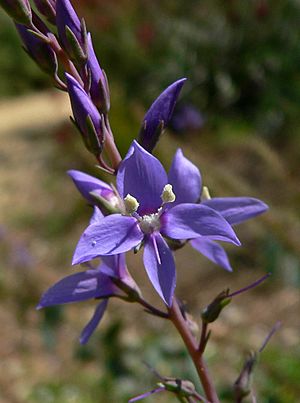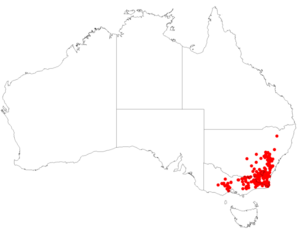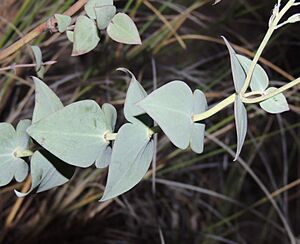Digger's speedwell facts for kids
Quick facts for kids Digger's speedwell |
|
|---|---|
 |
|
| Scientific classification | |
| Genus: |
Veronica
|
| Species: |
perfoliata
|
 |
|
| Occurrence data from Australasian Virtual Herbarium | |
| Synonyms | |
|
|
The Veronica perfoliata, also known as digger's speedwell, is a common plant found in the mountains of south-eastern Australia. It's a type of perennial herb, which means it lives for more than two years. This plant grows low to the ground and has many stems coming from a strong, woody base. You can spot it by its round, blue-grey leaves and bright violet-blue flowers. These flowers grow in sprays at the end of its arching branches. Sometimes, people even grow digger's speedwell in their gardens!
Contents
What Does Digger's Speedwell Look Like?
Digger's speedwell is a plant that stands upright, with woody stems that can arch and spread out up to about 120 centimeters (47 inches) long. Its leaves are smooth and a pretty bluish-green color, almost like they have a powdery coating. They are usually between 1.5 to 5.5 centimeters (0.6 to 2.2 inches) long and 15 to 40 millimeters (0.6 to 1.6 inches) wide.
Leaves and Stems
The leaves are shaped like an egg, either narrow or wide, and grow in pairs opposite each other on the stem. They can attach to the stem in different ways: sometimes like a wedge, sometimes like a heart, or even wrapping around the stem. The edges of the leaves can be smooth, slightly wavy, or have small, sharp teeth. Plants with narrower leaves often grow in drier places, while those with wider leaves prefer cooler, wetter spots. Each leaf has 3 to 9 veins running from its base. Many woody stems grow from the plant's root system, forming a bushy clump.
Flowers and Seeds
The flowers grow in a tall, slender cluster called a raceme, which can be 10 to 45 centimeters (3.9 to 17.7 inches) long. Each stem can have between 25 and 70 flowers! When the plant is making seeds, the small stalk holding each flower (called a pedicel) is about 5 to 12 millimeters (0.2 to 0.5 inches) long. The smooth parts that protect the flower bud (called calyx lobes) are 3 to 5 millimeters (0.1 to 0.2 inches) long.
The individual violet-blue flower petals are 7 to 12 millimeters (0.3 to 0.5 inches) long. After flowering, the plant produces egg-shaped seed capsules. These capsules are 4.5 to 8.5 millimeters (0.2 to 0.3 inches) long and 2.8 to 3.5 millimeters (0.1 to 0.14 inches) wide. They are not very flat and can be either rounded or pointed. Digger's speedwell usually blooms from October to February.
Why is it Called Digger's Speedwell?
The scientific name for this plant, Veronica perfoliata, was first officially described in 1810 by a botanist named Robert Brown. The word perfoliata means "perfoliate leaves." This describes how the stem seems to pass right through the leaves, making them look like they are pierced.
The common name "digger's speedwell" has an interesting story. It comes from an old belief that if you found this plant, it meant there might be gold nearby! "Speedwell" is also a general name used for several different types of Veronica plants.
Where Does Digger's Speedwell Grow?
Digger's speedwell grows in high places, between 530 and 1780 meters (1,740 and 5,840 feet) above sea level. You can find it in mountain meadows, heathlands, and forests with eucalyptus trees. It grows in New South Wales, the Australian Capital Territory, and Victoria.
This plant often grows in shallow, rocky soil on steep slopes. It can be found in similar areas to another plant called V. derwentiana, but digger's speedwell prefers rockier, shallower soils instead of deeper, shaded ones. Even though people once thought it showed where gold was, this plant actually grows in many different places across a wide area.
Images for kids




